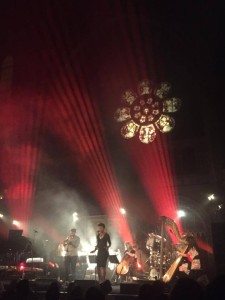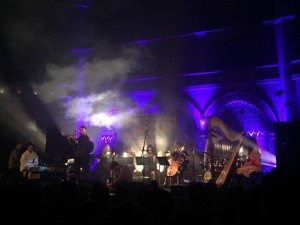Matthew Halsall & The Gondwana Orchestra – Live at The Union Chapel, London
Matthew Halsall’s tour manager must be very pleased with himself for having bagged The Union Chapel (voted ‘London’s Best Live Venue’ by Time Out) for the artist’s flagship gig on his new tour. Striking a balance between jazz-club intimacy and concert-hall splendour with un-reserved, pew style seating, it provides the perfect setting for the existential jazz of Halsall and his orchestra, which is best heard in larger spaces where the instrumental timbres can resonate, yet is so mellow and relaxed that the audience need to be seated close to fully connect with it.
It’s a space that Halsall wastes no opportunity to exploit; entering the venue feels like stepping back into Victorian London, as smoke climbs up from the altar and is picked out by the dramatic lighting all the way to the large stain glass windows. After an almost inaudible introduction (do you have to have the voice of a mouse to make calm, beautiful music these days?) the ensemble launch into the title track from their first collaborative album, When the World Was One, released last year.
The blueprint for most of the album and indeed Halsall’s solo catalogue tends to be grounded in a simple, repeated bassline accompanied by delicate, modal chords from the piano and harp, with a smattering of brushed drum rolls. These provide the springboard for the soloists to explore long, contemplative musical ideas in which each note feels individually considered and weighted – the hallmark meditative style that has won Halsall his position amongst the most prominent figures in the European Jazz scene.
Entering the venue feels like stepping back into Victorian London, as smoke climbs up from the altar and is picked out by the dramatic lighting all the way to the large stain glass windows
Halsall’s arrangements give the musicality of all the performers’ ample chance to shine through, with strong
solos from Jordan Smart (alto sax, bansuri flute), Taz Modi (piano), Luke Flowers (drums) Rachel Gladwin (harp), Gavin Barras (double bass) and Halsall himself (trumpet). Whilst all deliver strong performances through album highlights ‘A Far Away Place’, ‘Patterns’ and ‘Kiyomizu-Dera’ in the show’s first half, Modi’s virtuosic and sweeping piano styling in his solo stands out among the rest. If it weren’t for the fact he’s a middle-aged white man from Manchester, you’d be forgiven for thinking Halsall was the lost child of John and Alice Coltrane, so well does his music marry the laid-back directness and reaching spirituality of Jazz’s royal couple. With the closing track titled ‘Tribute to Alice Coltrane’, this is clearly an influence who’s importance Halsall isn’t trying to hide.
After a short interlude the audience return to find a stage with considerably more instruments on it; so sets the tone for the collective’s latest LP and focal point of the night Into Forever. On the latest record Halsall attempts to break away from the stream of consciousness style of his own albums and for the first time incorporates vocalists and a string quartet, as well as more funk/soul orientated basslines and rhythmic patterns. The audience are treated to guest vocalist Josephine Oniyama’s grounded and earthy tones on the tracks ‘Only a Woman’, ‘As I Walk’, and ‘Badder Weather’, which despite their technical competency, perhaps sonically and lyrically contrast too much with the general tone of the ensemble to complement each other.
If it weren’t for the fact he’s a middle-aged white man from Manchester, you’d be forgiven for thinking Halsall was the lost child of John and Alice Coltrane
Much better suited to the ambience of Halsall’s music is the breathy singing of Bryony Jarman-Pinto who only features once on the album for ‘Jamais Vu’, much to the record’s loss. Annoyingly Pinto’s beautiful scatting is lost to some degree due to poor sound mixing by the engineers, and this earmarks a more general issue for the latest album when performed live. With so many instruments on stage the music becomes to some degree more obviously pre-composed and loses some of that ethereal freeness we hear on earlier albums. With Halsall’s obvious competence for creating tranquil, pulsating jazz arrangements, however, as evidenced in the invigorating encore cover of the Cinematic Orchestra’s ‘Big Sea’, there is little doubt that this is a balance which he will continue to perfect in later efforts.



Comments